Matador Network's Blog, page 865
May 6, 2020
Portland Naked Bike Ride 2020

COVID-19 has led to the cancelation or postponement of most of the world’s major events, but one event is still happening right on schedule: the World Naked Bike Ride in Portland, Oregon. Although cities like St. Louis, London, and San Francisco canceled the event, Portland, Oregon, is insisting that it still takes place on June 27. But it’ll look a little different this year.
Usually, naked bikers gather at a set time and location. This year, however, participants are being encouraged to strip down and ride wherever they want, whenever they want. So, while the riders won’t all be riding together, they’ll still be riding nude around the city of Portland — only separately, so Portlanders shouldn’t be surprised to see the occasional solo nude biker out and about.
Pedalpalooza, the organization that oversees the event, said, “It might take even more courage than usual, but if any city has the creativity to make it fun, it’s Portland.” On Facebook, it added, “We simply must put the safety of Portlanders first.”
The event’s goal is to call attention to society’s dependence on pollution-based transport, as well as promote body positivity and cyclist safety. Last year, the ride drew 10,000 participants. Due to these large numbers, it’s clear that holding the event in the traditional fashion would be a violation of social-distancing regulations. The new format might be a departure from the familiar, but with so many determined cyclists around Portland, it’s bound to be a success no matter the format. 

More like this: The 7 most epic bike tours around the world
The post This year’s Naked Bike Ride in Portland will be pandemic-proof appeared first on Matador Network.
May 5, 2020
Denver Zoo baby rhino cam

The best part about working from home is that you can spend two hours watching a live baby rhino cam, and no one can call you out on it. The Denver Zoo just released a livestream of a baby rhino, and it’s easily the best excuse to take a suspiciously long lunch break.
“You asked and we listened!” said the zoo. “We now have a Baby Rhino Live Cam up and running. You can enjoy our greater one-horned bundle of joy right here.”
View this post on InstagramA post shared by Denver Zoo (@denverzoo) on Feb 26, 2020 at 9:24am PST
The rhino calf is named Joona and can be seen every day hanging out with her mom, Tensing, inside their bedroom. As the weather warms up, however, Joona is expected to venture outside more frequently, so if you tune in and don’t see her, don’t worry. She’s just catching some rays.
Today's #bringingthezootoyou Virtual Safari is brought to you by the cutest greater one-horned rhino gal! Tune on Facebook in at 2 p.m. MDT today (because baby takes her daily nap at 1 p.m.), or check out https://t.co/SrPiKSreHq for the replay! #ClosedButStillCaring pic.twitter.com/tcIyPNy1MS
— Denver Zoo (@DenverZoo) March 25, 2020
Joona is a greater one-horned rhino born in captivity from 13-year-old Tensing on February 22, 2020. The greater one-horned rhino is found in Northern India and Southern Nepal, but there are only about 3,500 individuals in the wild. The species is listed as vulnerable by the World Wildlife Foundation.
In addition to Joona’s live stream, the zoo also offers a virtual safari program featuring videos of other animals, from Humboldt penguins to Vietnamese potbelly pigs, in an attempt to stay connected with the community.
In a news release, the Denver Zoo said, “The Zoo is reaching out to the community with a new resource to help families stay connected to its animals and stave off cabin fever during this difficult time. Zoo to You: Virtual Safari will be updated daily with new animal videos, wildlife-themed activities, and other ideas that families can do at home.” 

More like this: Botswana is evacuating its endangered black rhinos to save them from poachers
The post The Denver Zoo’s baby rhino cam is the most adorable thing you’ll see today appeared first on Matador Network.
Virtual tour of Wuhan, China
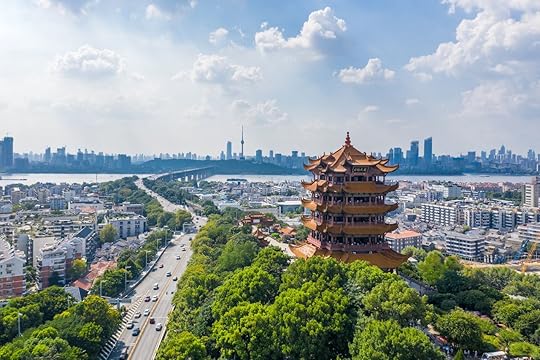
Few Americans might have been aware that Wuhan, China, is known as “The Chicago of the East” before the first half of 2020. Now it’s the most talked-about city on Earth, and there’s a growing interest in understanding more about Wuhan and how people live there, both before the pandemic hit and now that quarantine restrictions have relaxed.
Of course, going there to find out isn’t realistic right now, but a chance to learn about Wuhan — from a local — seemed enticing enough to try out one of many virtual tours being offered now that physical travel is off the table.
So I joined a group of 50 people with Walks — a walking tour company that typically runs tours in cities around the world — for an hour trip through Wuhan. Our guide for this journey was Zhou Akim, an English teacher enrolled at the University of Sydney who, when she’s not in school, calls this city on the Yangtze River home.
Her hour-long slide presentation was both fascinating and somehow calming. Over the course of her virtual tour, Akim showed us that Wuhan is a massive, modern city full of people who do everything outdoors — from drinking tea to conducting business — and prefer noodles for breakfast.
Glass towers and golden pagodas mark a modern skyline
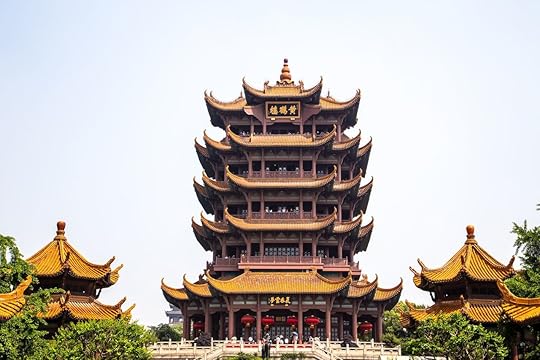
Photo: livingmaster/Shutterstock
From the start, we got an idea of how truly big Wuhan is — five times the size of London — with a population of around 11 million. The skyline is an impressive lineup of glass towers, centered by the Tortoise Mountain TV tower, making it look almost like a smaller version of Shanghai. Between the modern skyline and the city’s historic landmark Yellow Crane Tower flows the Yangtze River, which glittered bright blue against the green trees on either side.
Akim led us over the Yangtze River bridge, the city’s main bridge, which supports both cars and rail. “The local legend says that if you walk across the bridge with someone special, you find love forever,” she said.

Photo: vivienniu/Shutterstock
From the bridge, we continued across to the Wuchang district of the city (it was once three separate towns separated by rivers) and Wuhan’s most famous structure, the Yellow Crane Tower.
“According to legend, it began with a wine store owner,” she said of the glorious golden pagoda, which has stood in some form for 1,800 years. “One day a beggar came to the store and asked for drinks, and the owner’s son was a generous man and gave the beggar food and wine. One day the beggar decided to repay his kindness and drew a crane on the wall of the store. The crane was a magic crane that danced on the wall. People came to see it, and the family grew rich and built the tower in the spirit of kindness.”
She then told us that, in truth, the Yellow Crane Tower was actually built as a military watchtower, but it was a nice piece of local flavor and legend — the story you’re looking for when you’re traveling to a new place.
An outdoor culture forced inside
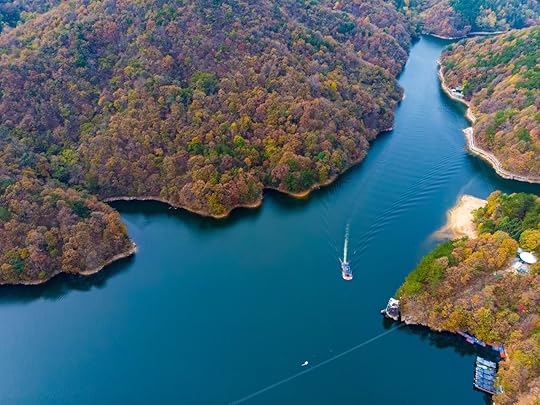
Photo: Hao Wan/Shutterstock
Akim then led us out of town to Mulan Mountain, named after the female military hero who most Westerners will know from the Disney movie of the same name. Akin filled us in on Mulan’s backstory (she dressed as a man to fight in the army), and we also learned that the actress depicting Mulan in the upcoming live-action film hails from Wuhan.
Akim also used the opportunity to tell us about the outdoors spirit of the city. Many residents of Wuhan flock out of the city to hike around the mountain and even prefer to be outside once they’re back in town.
After that, she led us through the Hankou district, “the most amazing place in Wuhan, and also where I live.”
We saw photos of the bustling outdoor antique market where people buy cookware, jade, books, and other household goods. We saw food markets in the open air, similar to those you might find in other places in Asia, like Thailand or Indonesia.
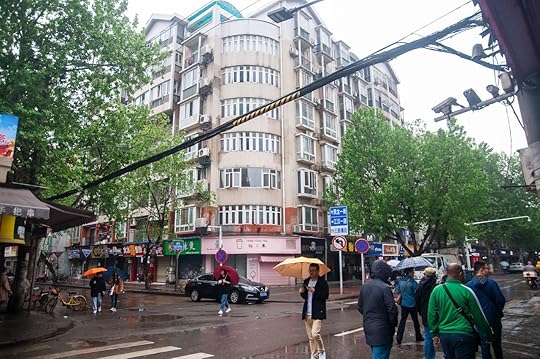
Photo: ellinnur bakarudin/Shutterstock
“People live kind of an old-fashioned lifestyle here,” Akim said, sharing that most people prefer shopping in these outdoor markets than grocery stores.
Next, we learned of Wuhan’s breakfast culture and how in this city breakfast is traditionally a meal eaten outside, often at one of the hundreds of tiny breakfast vendors.
“You find a chair to sit in, then you find a larger chair, and that’s your table,” she said, showing images of people enjoying breakfast in alleys between apartment buildings, on pedestrian streets, and in front of breakfast shops. It seems clear that most people in Wuhan are eager to get back to the city’s bustling café culture.
Food and tea center daily lives

Photo: Robert Way/Shutterstock
“There are 30 different kinds of breakfast you can have in Wuhan,” Akim said proudly. “That means you can go a month without repeating your breakfast.”
The traditional breakfast foods she showed us are all part of China’s rich culinary heritage: Bean curd, rice cakes, rice wine with eggs, and the famous hot dry noodles.
Lunch was an equally eye-opening experience, with a slide of delicacies like pig knuckle stew, Wuchang fish, duck neck, and steamed pork with rice flour filling our screens.
Barbecue is the most popular food in Wuhan, with stalls lining the streets grilling mostly lamb but also some tofu and vegetables. The style was brought there from the nomads of inner Mongolia who migrated to east-central inland China. It’s become a regional staple here much the same way it would be in Memphis or Kansas City.
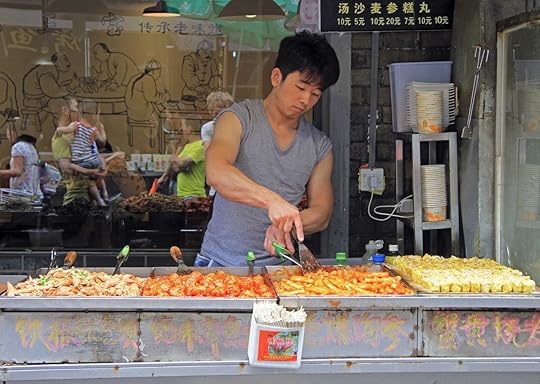
Photo: Andrew Babble/Shutterstock
We also learned about the ubiquitous lotus root, the foundational starch in most Wuhanese cuisine. Lotus and rib soup is Wuhan’s local stew, and lotus root soup is the steaming cure-all for whatever ails you. For dessert, Wuhan specializes in a steamed pumpkin rice cake, which has a slightly sour taste.
“My mom was watching TV with me one day while I was babysitting my nephew,” Akim told us. “And she pointed to the screen and said ‘What is that cartoon you’re watching with the steaming rice cake who can talk?’ I said ‘You mean Spongebob?’”
From there we ventured into Wuhan’s maze of tea houses and tea markets, a family business for our guide and a cultural institution. We saw images of people sipping tea and playing mahjong in the shops, some of them clearly European or American laughing and smiling like they were on the deck of a cruise ship.
“People come to the tea market and sit outside,” she said, elaborating on the city’s obsession with the outdoors. “We even do business outside. These people might be having a business meeting. In Wuhan if we can do something outside, we do it outside.”
A dose of local culture and a look at the road back
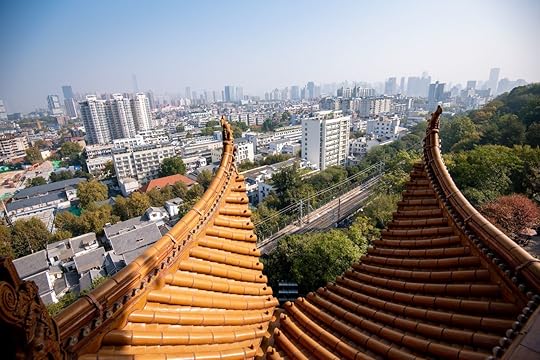
Photo: KernelNguyen/Shutterstock
Finally, Akim hipped us to a few local colloquialisms and language nuances.
“People say our dialect sounds grumpy or rude,” she said of the local language. “But that’s not what it’s meant to be. It’s just how we talk.”
She said that people in Wuhan sometimes fight over restaurant checks as a sign of love and admiration for friends and family, and warned us that the local word for zebra — gebama — also borders on profanity.
Finally, we saw some images of life in Wuhan during the outbreak. Akim had been a volunteer during the height of the pandemic, delivering groceries to people, and we saw how she — and others in similar positions — wore white hazmat suits to go about their daily business.
“I remember the first day I went to work, the whole neighborhood was empty, no one walked the streets,” she said. “And the only ones I saw were wearing white protective suits and police.”
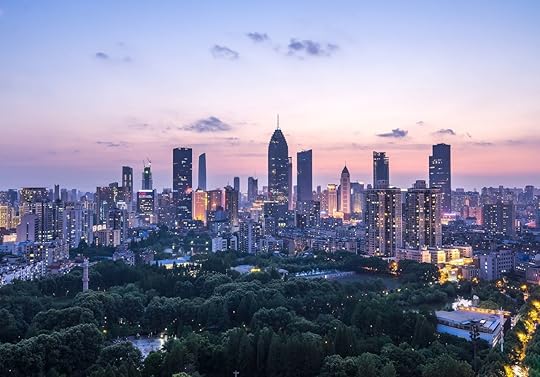
Photo: sleepingpanda/Shutterstock
Since April 10, she said, the city has started to slowly return to normal. She showed us a video of the streets, which weren’t totally empty but not how one would imagine a city of 11 million people to look either.
“People are starting to eat breakfast again,” she said hopefully. “But everyone needs to be patient.”
Though our trip through Wuhan was limited to photographs and the words of a local guide, it still gave us a look into a city that’s somehow dominated the news without telling us anything about the place itself. The virtual tour showed us all that Wuhan is a city in which tradition meets technology, where people love to go hiking and take breakfast very seriously.
Walks has two more virtual tours this month — Thursday, May 7, and again on May 14. And if you’d like a virtual tour that sheds some serious light on a place it’s worth getting to know since it became famous, it’s worth the 10 bucks and hour of your time. 

More like this: In Wuhan, hot dry noodle vendors reopening is a welcome sign of normalcy
The post I took a virtual tour of Wuhan, and it showed a side of the city the news misses appeared first on Matador Network.
Nunavik, Quebec, Arctic north travel

Located just two hours from Montreal by plane, Quebec’s northernmost region is more accessible than you might imagine. But upon arrival, the all-encompassing tundra and Arctic wildlife will have you convinced you’ve traveled much further. Nunavik, which means “great land” in the area’s Inuit language, covers almost 110 million acres in Quebec’s Arctic north but has little more than 13,000 inhabitants. Roads terminate hundreds of miles south of the region, isolating it from the rest of the province. And when you head north for the first time, that sense of disconnection and unfamiliarity is unmistakable.
While planning a trip north requires more flexibility than more accessible destinations, the payoff is worth it. Polar bears roam along the coastline — and further inland, as well, due to the warming climate — while icebergs float in the Hudson Strait to the north and Hudson Bay to the west. Adventurers head east into the Torngat Mountains, skiing seldomly schussed lines or hiking through the mountainous landscape. Others choose to soak in the unique Inuit culture, savoring a way of life more in touch with the land.
Solitude is easy to find.

Photo: Catherine Boivin/Shutterstock
When thinking of remote adventurous destinations, Alaska is frequently at the top of the list. But Nunavik, which is about a quarter of the size of Alaska, has only a sixtieth of the population. Of course, a lot of Nunavik’s Arctic tundra is inaccessible, but you don’t have to venture far from any of its villages to be alone.
Often, arranged itineraries afford visitors the opportunity to venture far away from the villages, deep into the Arctic wilderness. But even arriving in Kuujjuaq, the main town offering air service between Montreal and the region, is like stepping into a different world. Nine out of 10 inhabitants in the region are Inuit, and Inuktitut is the locally spoken language. A mere stroll to the outskirts of town brings you solitude and spectacular views of the tundra.
You can learn about an ancient way of life.
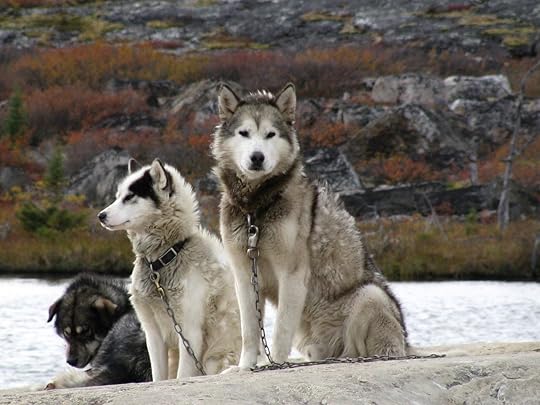
Photo: Angelique clic/Shutterstock
The ancestors of the ethnic Inuit who make up most of Nunavik’s population lived solely off the land until the 1950s and ‘60s. Today, although nomadism is no longer the primary way of life, Inuit do their best to keep their culture and traditions alive. Children, who are now raised with snowmobiles as their source of transportation rather than sled dog teams, are still taught to hunt, fish, sew, and live off the land.
Some continue to raise qimmiq, or sled dogs, recreationally, paying homage to the elders who relied on the animals just 70 years ago. Cultural centers throughout Nunavik are also dedicated to educating visitors about these 4,000-year-old traditions. Elders enjoy telling stories about their ancestors and personal past, which give visitors a glimpse into the Inuit ways of living.
The landscape is vast and pristine.

Photo: Gabriel Lacoste-Piotte/Shutterstock
Throughout the US, southern Canada, and much of the developed world, wild areas are often interrupted by roads and hotels, scarring what was once a pristine landscape. Tourists drive loop roads through national parks, stopping at paved viewpoints to snap selfies before heading back to a town that now occupies a space once inhabited by wildlife.
You won’t find such a scene up north. With the exception of a few miles of roadway here and there, roads remain in the confines of each of Nunavik’s 14 villages. Outside, the land exists as it always has: unspoiled by mankind. Arctic char swim in the region’s lakes and rivers, and caribou and musk-ox continue to roam among the tundra.
It’s paradise for adventurers.

Photo: Catherine Boivin/Shutterstock
Nunavik is home to four of Canada’s national parks, some of which see fewer than a hundred visitors per year. And these parks, which offer diverse landscapes, also provide a wide range of opportunities to recreate outdoors.
In Kuururjuaq National Park, visitors hike along the Koroc River Valley, following in the footsteps of the Inuit who called the valley home for thousands of years, while others hike alpine trails, ski steep lines, or snowshoe in the boreal forests in the Torngat Mountains. Visitors to Tursujuq National Park, Quebec’s largest national park, cross-country ski along the Hudson coast or watch for belugas beyond the bow of their sea kayaks.
Geology is the highlight of Pingualuit National Park, which is home to a perfectly round, clear and blue lake formed by a meteor 1.4 million years ago. At over 1,200 feet deep, it is also one of the deepest lakes in North America. While exploring the park, visitors also often hike to the picturesque Puvirnituq River Canyon, which is accessible from basecamp.
Ulittaniujalik National Park is the newest in Nunavik and, as a result, currently has limited access and opportunity for exploration. But Nunavik Parks does have plans to offer paddling trips down the George River.
If visiting any of Nunavik’s parks during the winter months, the chances of seeing the Northern Lights dance overhead are high. While exploring the parks, keep your eyes peeled for abundant Arctic wildlife, including seals, beluga whales, caribou, musk ox, polar bears, and ptarmigan, to name a few.
Planning a trip is easy.

Photo: Catherine Boivin/Shutterstock
Arranging travel to Nunavik on your own can be a challenge. Many of the parks are difficult to access without the use of a chartered plane or snowmobile, and flights and food can be expensive. It can also be dangerous to explore these wild areas without knowledge of the land and wildlife.
Luckily, Nunavik Parks offers a number of packages to each park, inclusive of flights to Montreal, guides, food, a few nights in one of the villages, and all logistical hurdles. Packages typically start around $4,000 for nine days, which isn’t bad considering a flight from Montreal to Kuujjuaq alone often costs around half of that. It’s also possible to work with Nunavik Parks to create a self-guided or custom itinerary, giving you the freedom to choose your own adventure. 

More like this: In Juneau, Alaska, summertime means dog sledding and ice-cave hiking
The post Nunavik, Quebec, an Arctic wilderness, is only two hours from Montreal appeared first on Matador Network.
Is swimming with whales in Tonga OK?

The bottom of our boat slaps against frothy waves as we head away from the calm waters of the Blue Lagoon Resort and out into the open ocean. I let my hair down out of its messy bun and scoot toward the back of the boat, my fins and mask in hand. Salty wind blurs my vision as we press on further and faster until finally, our guide Uli slows the boat down, points north, and bellows, “Tofua’a – Whale!”
Uli shouts in Tongan to his deckhand Tao, who leaps from the boat and plunges into the Pacific. I watch him intently, eyes fixed on the tip of his snorkel. It’s the first morning of our expedition to the Kingdom of Tonga and we are in search of the main attraction. Suddenly, from about 150 feet away, Tao raises his right arm straight into the air. “Go now!” Uli yells. I shove my snorkel into my mouth and lower myself into the water.
Once beneath the surface, I gaze down into the blue abyss below me, no bottom in sight. I fight the waves and swim closer to Tao, feeling my excitement growing and my breath quickening as I search the deep shadows below me. Then, something massive looms up out of the blue — a humpback whale.

Photo: Scott Sporleder
Over the next week, our team from the Blue Latitudes Foundation (BLF), as well as two members from the Matador Network crew, would have the opportunity to swim with about 10 humpback whale individuals, males and females, young and old, and the butterflies never left my stomach. Each day, we learned a little more about them, their relationships with each other and their relationship with us. Most importantly, we learned about the unique connection between the local Tongan people and the whales.
Tonga is a remote collection of over 170 small islands, located in the South Pacific between Fiji and New Zealand. Each year, beginning in June, humpback whales migrate over 3,500 miles to Tonga’s waters to breed and give birth. They spend several months in the protected lagoons and bays of the Tongan islands nursing their young, and this relative proximity to land draws in the attention of travelers from around the world hoping to catch a glimpse of these amazing creatures. Tonga is one of the only places in the world where you can get in the water with the whales, accompanied by a guide, as part of the regulated ecotourism industry.
But swimming with the whales was not always a standard industry in Tonga. In fact, Tonga’s humpback whales used to be hunted, as the whale meat, bones, and fat offered a significant source of income and food for the local communities. While hunting was small-scale and sustenance-based in Tonga, it was prominent internationally, so much so that the humpback populations fell to an all-time low of only 250 individuals and Tonga’s waters, which once vibrated with their seasonal songs, were nearly silenced. Recognizing this potential loss, in 1978, King Taufa’ahau Tupou IV declared a moratorium on all whaling within the kingdom’s waters. Since the ban on whaling, humpback whale populations in Tongan waters have slowly increased to over 1,500 individuals.
Today, Tonga’s waters are seasonally populated by the children and grandchildren of that original tribe of whales nearly hunted to extinction. And the Tongan people mirror this generational shift, with very few Tongans remaining who remember hunting the whales. It was this unique change in relationship that drew us to Tonga, to swim with the whales, learn from the new generation of Tongans about their attitudes toward the marine mammals, develop a better understanding of this generational shift toward ecotourism, and ask: Is it sustainable?
This relationship is nuanced. Tongans need the whales, but also understand that they do not own them and cannot rely on them. They respect them, but also have a history of hunting them for food. Over the course of this expedition, the BLF team sought to capture this complex relationship on film, through social surveys and by collecting acoustic recordings, and examine how this relationship may be beneficial to the sustainability of Tonga’s environment, economy, and culture.
The BLF is a 501(c) nonprofit organization, exclusively for charitable, educational, and scientific purposes. We elevate the traditional concept of ocean stewardship by uniting government, industry, and the community to work together to conserve our oceans. In doing so, the foundation strives to explore innovative solutions to traditional marine conservation challenges.
And what we found is that it’s more complicated than we thought. Since 1993, when Tonga began to monetize swimming with whales through ecotourism, the number of whale swimming operations have increased with foreign operators moving in to take advantage of the three-to-four-month whale swimming season. In fact, of the 35-50 licensed whale-watching vessels in Tonga, only 20 percent are entirely Tongan owned.
As a result, more and more Tongans are being forced to leave the island to find work, especially given the limited opportunities to expand their income locally. And as ecotourism operations continue to increase, there’s a greater risk of impacting the sensitive whale habitat, which may lead them to not return to these waters.
However, the ecotourism industry in Tonga has had a relatively slow increase over the past decade, when compared to other nearby island nations and the ecosystems, including coral abundances and fish richness, are doing well. And, ecotourism has brought in income to the locals, while also helping to conserve the whales’ nursery grounds and protect their migratory waters.
So, with this understanding, we again asked: Is it sustainable? And the truth is we don’t have the answers now, but what we do know is that the Tongans have a unique core value at the center of their ecotourism growth that makes them stand apart from the other ecotourism practices: the idea of faka’apa’apa, the Tongan respect for the whales. It’s this respect that is keeping ecotourism growth and development sustainable. With this respect, the new generations of Tongans are striving for a balance, where they can use their ocean resources without using them up. 

More like this: Where to swim with the world’s most amazing marine wildlife
The post Swimming with humpback whales in Tonga is awe-inspiring, but the activity’s sustainability is precarious appeared first on Matador Network.
Underground pit barbecue styles
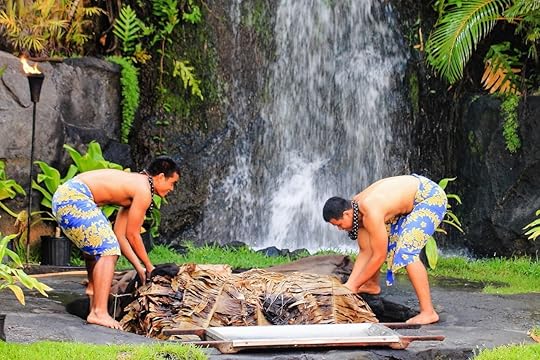
Barbecue is about the closest thing that humans have to a universal cooking style. In countries around the world, people barbecue meat and vegetables over fire. Each method is slightly different — the Chilean asado has the meat spread upright against a large open fire, for example, while Japanese yakitori uses narrow charcoal grills. And then there’s the style that’s among the oldest and most traditional: barbecue done in an underground pit.
Pit barbecue is especially prevalent in countries in the South Pacific, but historic styles can be found in other parts of the world as well. Some are rare to come by beyond special occasions, like the New England clam bake, which comes from a Native American cooking style of baking seafood in a charcoal-and-seaweed-filled hole on the beach. Other types of pit barbecue, however, thrive year round.
These are the underground barbecue styles from around the world to keep on your bucket list.
1. Hawaii: imu
Kalua pork, which means “pork baked underground,” is the heart of nearly every Hawaiian lu’au. The initial concept is simple: a whole pig wrapped in banana leaves and baked for a day in a dirt-covered pit called an imu. What makes this preparation work is a long, slow process.
Preparation starts at least 11 hours before dinner is to be served. First, a hole between three- and five-feet deep is dug and lined with banana leaves. A fire is started inside, and rocks are added. The pig is prepared as the rocks heat up. When they’re white hot, the wood is removed, and most of the rocks are lined around the pit while a handful are stuffed into the pig. The pig is placed in the hole and then covered with banana leaves, tarp, and sand. Around nine hours later, a fully cooked pig is ready to be dug up and served.
2. Fiji: lovo
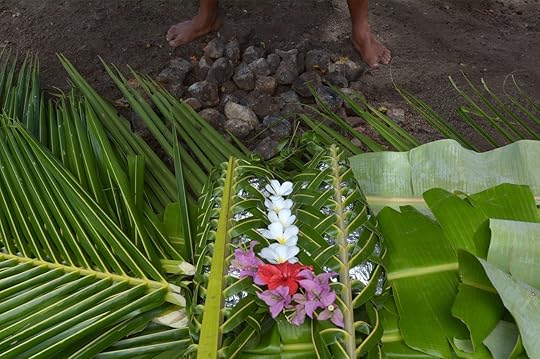
Photo: ChameleonsEye/Shutterstock
In Fiji, the underground barbecue is called lovo. While it’s an all day affair like the others on this list, the top usually skips the earthen covering and relies on tightly woven banana leaves instead. Typical meats include spiced whole chicken and large cuts of pork while local vegetables like sweet potatoes and cassava are wrapped in banana leaf packets as well. The hole is dug early in the morning, and rocks are heated over wood before the wood is cleared and the stones are arranged so they’re flat. Banana stalks are laid over the rocks like the bars of a grill. The food is stacked from bottom to top with meat, then vegetables, then desserts like vakalolo, which is a type of coconut and cassava pudding wrapped in banana leaves. The final meal is ready after about four hours of cooking.
3. New Zealand: hangi
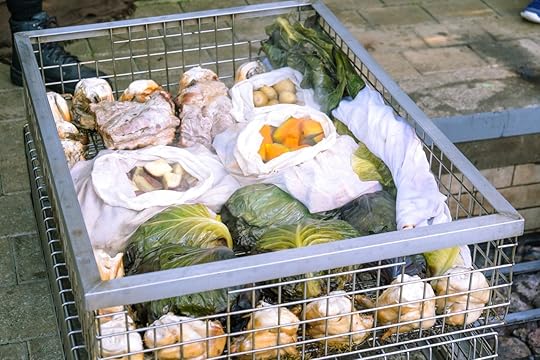
Photo: corners74/Shutterstock
The underground oven used by the indigenous Māori people of New Zealand is called a hāngī. It uses hot stones and a soil covering to trap the heat. The most traditional foods cooked in a hāngī include fish, poultry, and vegetables like sweet potato that are wrapped in flax leaves. Modern hāngī include pork and lamb, and aluminium foil baskets and cloth sacks often replace the leaves.
Hāngī are still popular today in parts of New Zealand. A modern iteration has the food in individual or small-group packs that can be sold as takeout. Depending on the size of the packs and what type of meat, the food is cooked underground for around four hours.
4. Papua New Guinea: mumu
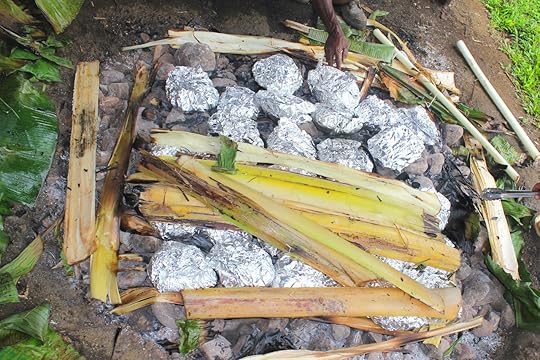
Photo: Wayne Via/Shutterstock
Papua New Guinea’s underground barbecue is called mumu. The cooking is done in a pit filled with hot stones, and it’s covered with long-bladed grass, vegetable fiber sacks, and banana leaves. In the middle, there’s usually yams, sweet potatoes, taro, and whole pig. Coconut is often added in coastal regions while gourds and other vegetables are included farther inland.
A mumu with gourds differs from others on this list by one major way: sticks that lay horizontally between the hot stones and food. When most of the other preparations are complete, the sticks are removed, and water is poured in the holes left behind to create steam and cook the food for around three hours.
5. Mexico: barbacoa
Barbacoa is loved throughout Mexico and the US, but it’s far from a new style. Its origins are believed to date back to the Taino people of the Caribbean, who brought it to central Mexico long before Europeans arrived. In the Yucatan, the Mayans called these underground barbecues pibils, which are covered in the book Pre-Hispanic Mexican Cuisine: The Food of the Ancient Mexicans. Today, the more widely known version is barbacoa, which comes either from the Taino word meaning firepit or the Spanish phrase de la barba a la cola, which means “from the beard to the tail.”
Exactly what’s included in barbacoa depends on where you’re eating. Goat and beef are common while venison shows up in Sonora and chicken in Guerrero. Turkey and rabbit make appearances in barbacoas throughout central Mexico. Regional chilis and vegetables round the barbecue out. Regardless of what’s cooked, the method is similar: all of the meat and vegetables are put in a hole and then covered with banana or maguey leaves and soil. The result is a tender and juicy meat perfect for tacos or any other preparation.
6. India: tandoori
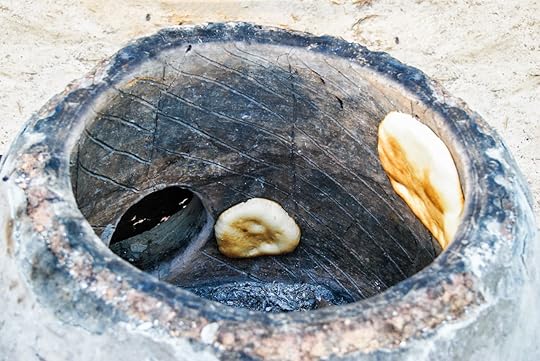
Photo: Stanislav71/Shutterstock
A tandoor is not like the rest of the underground methods on this list, but it is traditionally underground. A tandoor is a clay urn-shaped oven that can be as short as three feet or as tall as 21 feet. It’s often buried to the rim, which has a small lip. A charcoal fire is lit at the bottom of the tandoor and then spiced meat, often chicken or lamb, is cooked inside vertically. Bread dough is pushed on the sides to cook.
The tandoor is believed to have originated in the Middle East, and there are versions throughout North Africa and Central Asia. In Morocco the clay oven is called a tandir while in Turkey it’s called a testi. Perhaps the most widespread, however, is the Indian tandoor.
7. Tahiti: hima’a
Tahiti uses its natural environment to its advantage for its underground pit barbecues. The hole, which can be as wide as some other styles are deep (three to six feet), is filled with volcanic rock that’s heated by a wood fire before used to cook pork and vegetables. The meat and veggies are wrapped in large leaves, covered with more leaves, burlap, and soil, and then steam cooked for an afternoon. 

More like this: 9 styles of barbecue from around the world that should be your summer goals
The post 7 barbecue styles done underground from around the world appeared first on Matador Network.
Norwegian Cruise Line bankruptcy
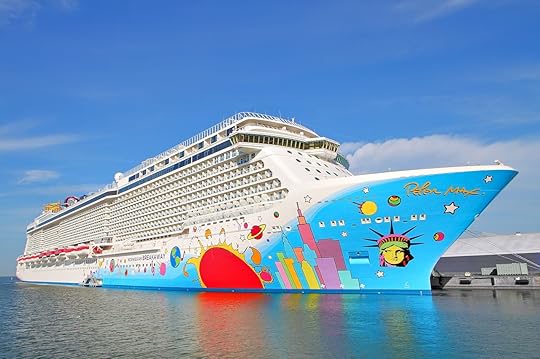
The entire travel industry has been hit hard by the COVID-19 pandemic, but the cruise sector has likely received the biggest blow. Several of the first large coronavirus outbreaks occurred on cruise ships, leaving passengers stuck at sea for weeks while they were denied docking at multiple ports — events that may have badly damaged the reputation of the cruise industry.
Despite Carnival’s intention to resume cruising operations on August 1, the future of many major cruise lines looks grim. Norwegian Cruise Line is in such dire straits that it expects to file for bankruptcy soon, citing the uncertainty surrounding the pandemic.
In a recent securities filing, Norwegian said it could not guarantee that it wouldn’t have to see waivers from lenders, and is at risk of default if it can’t amend credit agreements. According to the filing, the coronavirus outbreak, “including its effect on the ability or desire of people to travel (including on cruises), is expected to continue to impact our results, operations, outlook, plans, goals, growth, reputation, cash flows, liquidity, demand for voyages and share price. These factors have raised substantial doubt about the company’s ability to continue as a going concern.”
If the cruise line can’t maintain enough liquidity, it conceded that its “business and financial condition could be adversely affected and it may be necessary for us to reorganize our company in its entirety, including through bankruptcy proceedings, and our shareholders may lose their investment in our ordinary shares.”
It’s the first time Norwegian — and most other cruise lines — has ever completely suspended all its voyages, and is currently preparing cash refunds for passengers with canceled cruises. Although the company is offering 125 percent credits toward future cruises, half of the cruise guests have rejected the credits and requested cash refunds instead.
Even once travel advisories are lifted, many questions will still remain unanswered, like when international ports will open and what demand will look like for the beleaguered industry. 

More like this: Why a small cruise ship is the perfect solo getaway
The post Norwegian Cruise Line may file for bankruptcy over coronavirus losses appeared first on Matador Network.
Best museums in Africa
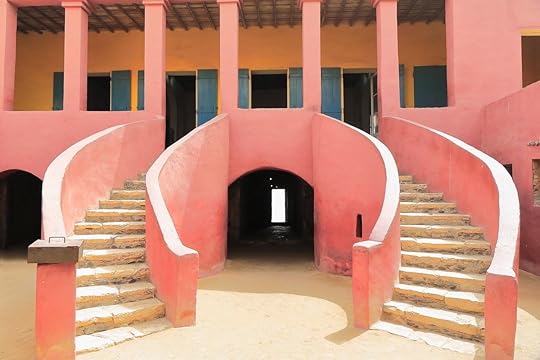
For black people across the diaspora, coming to Africa can be much more than a vacation. Many see it as a pilgrimage, one of returning to the home of their ancestors, so the normal trappings of the average holiday may not be enough for their journey. Visitors to the African continent are frequently there to experience the arts, letters, and history in a way that may not be required of other vacations.
Museums of all stripes act as collectors and aggregators of heritage, and on the African continent, they are as numerous and diverse as the many cultures therein. For those looking to infuse their trip to Africa with a bit more culture than your average vacation, here are eight fine examples of significant museums that black travelers especially will appreciate.
1. Le Musée Fondation Zinsou, Ouidah, Benin

Photo: Fondation Zinsou/Facebook
The Zinsou Foundation was created in 2005 to promote African art in Benin. Though its headquarters are in Cotonou where it maintains a modest exhibition space, the museum in Ouidah is a much more ambitious undertaking. Housed in a refurbished mansion, it holds the foundation’s permanent collection of contemporary African art.
Since the museum opened in 2013, it has made great strides in its mission to preserve the artistic heritage of Africa. Though the collection began with what the Zinsou family themselves donated from their own personal collections, its holdings have since grown considerably and feature work in many different mediums. Visitors to the museum will find the normal trappings of personal collections like photography, painting, and drawing, as well as 3D work like sculpture and installation. You’ll also find more ephemeral media as the focal point of events and exhibitions.
The foundation is the brainchild of Marie-Cécile Zinsou, the French-Beninese daughter of former Prime Minister of Benin, Lionel Zinsou, and the grand-niece of Émile Derlin Zinsou who was briefly the president of independent Dahomey following a military coup in 1967. For Marie-Cécile, being a part of a political family was a huge influence in her decision to create the organization, saying, “I guess I have a sense of duty; I think that’s a feeling you have when you come from a political family. You have a duty towards your country. After having an experience of working with children in an orphanage for two years, I felt that I had to do something and thought my part could be related to education. That’s how we started the museum and the libraries.”
As part of Marie-Cécile’s vision for the museum and the greater foundation to serve as the backbone for comprehensive arts education programs, admission to the museum, exhibition space, and attendance to any of their classes or events is always completely free.
2. The National Museum of Ethiopia, Addis Ababa, Ethiopia

Photo: Juan Aunion/Shutterstock
Though it houses many different important collections, the museum is most famously known as being the home of Lucy, a fossilized example of Australopithecus Afarensis, a species of early hominid that lived between 3.9 and 2.9 million years ago. Discovered in the late 1970s, she was named after the song played most frequently at the dig site where she was found, The Beatles’ “Lucy in the Sky With Diamonds,” though she also has an Amharic name, Dinkinesh, meaning “you are marvelous.”
Lucy became famous around the world, largely due to the book Lucy: The Beginnings of Humankind, written by paleoanthropologist Donald Johanson, who led the team that originally discovered Lucy in Ethiopia. Johanson himself assembled Lucy at the Cleveland Museum of Natural History, and after a multi-year tour of the United States organized by the Houston Museum of Natural Science, she was returned to Addis Ababa.
Lucy is undoubtedly a huge draw, but the museum has a lot more to offer. Begun as a project of the Institute of Archeology as a way to display its findings, the museum has grown into a full-fledged collector and preserver of the paleo-archeological findings and history of the country. It currently operates four main exhibitions, with only the basement dedicated to African paleontology and archeology.
On the first floor, you’ll find pieces relating to the history of the Ethiopian Empire, including those known to have been owned and used by Haile Selassie, the former emperor. The second floor shows the chronological history of the arts in Ethiopia, beginning with traditional handcrafts, jewelry, and utensils and ending with contemporary fine art. The final exhibition attempts to convey the greatness of the history of the country in a comprehensive ethnographic display.
3. L’Aventure du Sucre, Pamplemousses, Mauritius
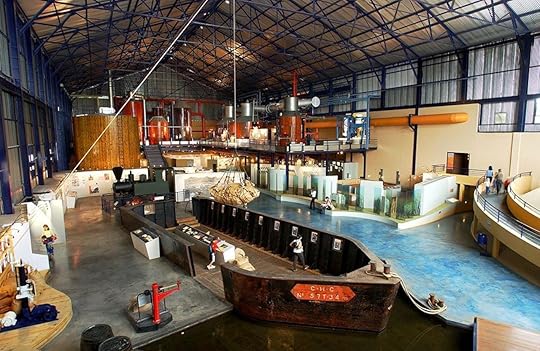
Photo: l’Aventure du Sucre/Facebook
Though sugar is now cheap and plentiful, it was once a commodity so sought after that its value in trade was akin to gold or silk. In Mauritius, sugar has long been a lucrative crop and is still cultivated there to this day, using some 85 percent of the country’s arable land. The Dutch were the first colonizers to capitalize on the sugar cane industry in Mauritius as early as the 17th century, but it was the French who transformed this production into a worldwide affair. By investing in infrastructure by producing the nation’s first modern sugar mills, they succeeded in legitimizing the Mauritian sugar trade on a global scale.
L’Aventure du Sucre is a museum dedicated to the complicated colonial history of Mauritius’s sugar industry, built in a former sugar refining facility. Located within the Beau Plan Sugar Estate, the museum is set at the end of a long boulevard flanked with coconut palms and bougainvillea to which the factory is juxtaposed. The vast and industrial interior is softened somewhat by the attractions therein: the lights and screens of the multimedia exhibits that are the backbone of a comprehensive tour.
The museum is also very near to the Pamplemousses Botanical Gardens, a 300-year-old attraction featuring some incredible flora and fauna. Visitors can see tortoises and java deer, as well as the always spectacular giant pads of the victoria water lilies that grow in its many ponds. Since it’s in the area, be sure to pay the gardens a visit as well.
4. Zeitz Museum of Contemporary Art Africa, Cape Town, South Africa

Photo: Zeitz MOCAA/Facebook
Operating as a public nonprofit, this museum is, in a lot of ways, the backbone of contemporary art on the African continent. Built in the refurbished Grain Silo Complex at the V&A Waterfront, Zeitz MOCAA has accomplished a great deal in its short history. Opened in 2017, it is the largest museum dedicated to African art of any kind in the entire world, and though it focuses on promoting both established and emerging artists, its laser-pointed focus is almost exclusively on works from the 21st century.
More than just a museum, Zeitz MOCAA acts as a platform for African and African diasporic artists, as well as a mediator and purveyor of arts education and discourse. Also headquartered on its premises are The Center for Art Education and The Center for the Moving Image, both dedicated to promoting their respective disciplines via instruction and display. It is currently curated by the world-renowned Cameroonian born Koyo Kouoh, the former artistic director of RAW Materials in Dakar, Senegal. She took over the curatorial helm of Zeitz MOCAA in 2018, and much of the museum’s continued success and viability in the world art zeitgeist is directly credited to her leadership.
5. Kigali Genocide Memorial, Kigali, Rwanda
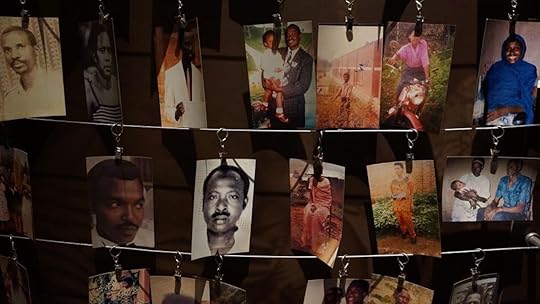
Photo: Kigali Genocide Memorial/Facebook
This memorial was built specifically to honor the victims of the 1994 Tutsi genocide in Rwanda. As their capital Kigali is nearly in the exact center of the country, it’s in an ideal location to serve as a place to reflect on the future of the country and for survivors to remember and pay respects to their loved ones.
The exhibitions are threefold, beginning with the largest, the one that thoroughly documents the atrocities of the 1994 Tutsi genocide. Starting with the pre-colonial history of what is now known as Rwanda, it takes viewers through the premeditated nature of the Rwandan genocide and extolls upon the successes of the opposition. Venture further into the museum to find the Children’s Room, which is dedicated to the memory and the scant remaining stories of the infants and children that lost their lives during this untenable period of Rwandan history.
A huge reason the memorial was conceptualized and constructed was to offer a respectable burial site for the people who were murdered. During and immediately after the genocide, the resultant human remains were either callously thrown into mass graves or left in the open to deteriorate, but a massive effort was launched to collect and reinter these people’s desecrated remains as a part of the memorial. An enormous portion of the memorial’s function today is to act as a dignified burial space for the people whose bodies were desecrated after their death and thereby offering visitors a reputable place to pay their respects.
A tremendous part of the mission of the memorial is to educate visitors about the pressures that led to the Rwandan Genocide as well as the consequences of it. By also including corollaries to other similar acts in history — like the Cambodian Killing Fields or the Holocaust — they aim to prevent future generations from repeating these atrocities in the future.
Though it’s not a huge memorial, leave more time than you would think you’d need for your visit. Upon their first visit, many find they need extra time to reflect on exactly what happened back in 1994, as few outside of Rwanda has actually been privy to this history in such a holistic way.
6. The Museum of Contemporary African Art Al Maaden, Marrakech, Morocco
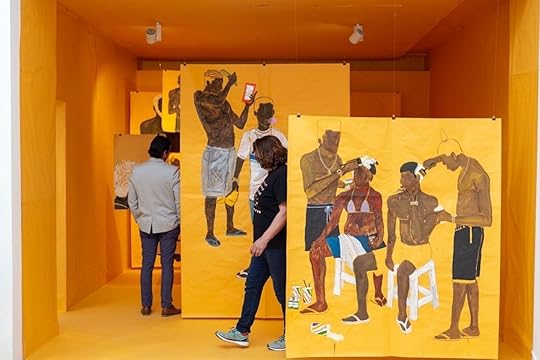
Photo: Museum of African Contemporary Art Al Maaden/Facebook
Delicately navigating its unique position to highlight both Middle Eastern/North African art and Sub-Saharan African art, the Museum of Contemporary African Art Al Maaden (MACAAL) in Marrakech houses both a permanent collection and rotating exhibitions that aid in exploring this confluence. Housed in a historic neo-Moorish building, this museum is brand new, having opened only in 2018.
Its exhibitions belie particular respect for work across many disciplines, as it’s equally likely to show a painting as it is a work of experimental digital media. The offerings also seem to reveal a drive to display work across a wide range and different types of experience, as you are likely to see work from both someone classically trained and somebody self-taught. Overall, the experience more closely captures both the experience of the layperson to the arts in Africa and the African artist relationship to the sometimes disjointed African art market.
In addition to the exhibition space, MACAAL has particularly dedicated itself to arts education evidenced by their offerings as far as instruction and residence. Most ambitiously, it offered a four-day boot camp for emerging African talent within the arts sphere. Created in conjunction with A Million Dots, 20 young professionals were invited to MACAAL campus in January of 2020 to participate in training and workshops taught by some of the greats in African fine art, like the aforementioned Marie-Cécile Zinsou, founder of the Zinsou Foundation in Ouidah, and Koyo Kouoh, director and chief curator at the Zeitz MOCAA in Cape Town.
7. Maison des Esclaves, Dakar, Senegal

Photo: rweisswald/Shutterstock
Though there is some debate as to the site’s actual role in the trans-Atlantic slave trade, La Maison des Esclaves — or the House of Slaves — nonetheless remains one of the premier memorials to the atrocities of chattel slavery in the entire world. Located on Gorée Island, about three kilometers from the coast of Dakar, it is home to the Door of No Return — the door through which kidnapped African people were marched through to board the boats that would take them to the Americas to be enslaved.
It is so named because, though escape from the house of slaves was radically uncommon, it was impossible after passing through the door and was the last time any of the Africans who were marched through it would see their homeland for the rest of their lives. And after the Door of No Return, only death would save them from their fate across the Atlantic.
Whether or not this Gorée Island installation was a major player in the trans-Atlantic slave trade or not, it is undisputed that it was, at some point, an active holding center for Africans awaiting their journey across the ocean. To most Africans, and especially to those from the African diaspora returning from the Americas, the distinction seems nominal or even completely unimportant — the gravity of the lessons to be learned at the museum remains just as salient.
The House of Slaves has, over the years, attracted its fair share of world leaders. Among its famous visitors are Pope John Paul II, Barack Obama, and Nelson Mandela, who reportedly stepped away from the tour to sit alone for a time in one of the basement cells. Though many have speculated on what exactly he was ruminating on so silently for those few minutes, he never saw fit to share it.
8. Grand Egyptian Museum, Giza, Egypt

Photo: Grand Egyptian Museum/Facebook
The cornerstone of the new master plan for the Giza plateau, the Grand Egyptian Museum (GEM) will be the largest museum devoted to archeology in the world. But hold off on your travel plans — it hasn’t yet opened, though after years of delays it is scheduled to start accepting its first visitors in 2020. A massive project, the museum has been in development for nearly 20 years, beginning with a worldwide contest to choose a design for the building. The winner, company Heneghan Peng from Dublin, Ireland, proposed an ambitious design: Shaped like a triangle, the north and south walls line up precisely with the Great Pyramid of Khufu and the Pyramid of Menkaure respectively, the front facade made from translucent alabaster.
Former Egyptian president Hosni Mubarak laid the foundation stone in 2002, thus ceremonially signifying the beginning of construction, though the bulk of the build did not begin until 2008 when the completion date was set in 2013. Unfortunately, there have been many delays in GEM’s construction, caused in large part by the Egyptian Revolution which led to Mubarak’s long-awaited resignation. Nonetheless, construction was eventually completed, and works are currently being moved from disparate museums, universities, and various other holdings across Egypt to their final home within GEM’s carefully designed walls.
The sheer number of items the museum will house will rival the collections of museums of any type worldwide. Not only will it become the home of the entire Tutankhamun collection, of which many items are making their public display debut, but it will house a total of over 50,000 items of Egyptian antiquity. No laypeople have been allowed to tour the museum yet, but a handful of journalists have entered in the final stages of construction and assembly, many of whom note that visitors to Egypt after the opening should allow at least one full day to explore the museum alone, as it will be far too vast to see in conjunction with the pyramid plateau. In the meantime, the world waits with bated breath. 

More like this: 8 underrated cities in Africa that every traveler would fall in love with
The post 8 museums in Africa that every black traveler should absolutely visit appeared first on Matador Network.
Ways mothers carry their babies

To provide safety, facilitate feeding, and promote mutual bonding, human infants, who are born helpless and defenseless, are traditionally in contact with their mothers day and night. But mothers also contribute at least half of the labor needed to keep their families and communities together, which means that mom needs her hands free. Maybe she’s weaving. Perhaps she’s gathering from the garden or traveling to get water from the village well. It could be that she’s cleaning the house and typing reports to sustain her woman-owned small business. Regardless of how she multitasks, her young child needs to be nearby. Creative beings that they are, mothers have solved this in several ways throughout history and around the world. Here are some of the most common solutions they’ve devised.
Babywearing

Photo: Blazej Lyjak/Shutterstock
Even though babywearing has dramatically taken off in the West since the early 2000s, leaving strollers in the dust, the practice is not new; it’s been the traditional way to transport infants around the world for thousands of years — some of the first examples of art depicting babywearing come from Egypt dating as early as 30 BCE.
Babywearing techniques include wrapping the child on the chest, carrying them on the back, or attaching them to the side of the body with baskets, cradleboards, cloth, and slings that range from traditional, colorful fabrics passed down through generations to factory-made carriers like Baby-Bjorn, ErgoBaby, and more.
In Africa

Photo: Vladislav T. Jirousek/Shutterstock
Mozambican mothers traditionally carry their infants in a piece of printed cotton material called a capulana. Capulanas are versatile pieces of cloth that can be used as a skirt, a veil, and/or a shawl to carry belongings and as a sling to carry babies. Said to have originated in India and circulated to Africa via trade routes, capulanas are common gifts for new mothers and come in joyful patterns and colors.

Photo: Peek Creative Collective/Shutterstock
Lightweight wraps called kangas appear to have originated in the Yoruba culture in Benin and southwestern Nigeria but are now found throughout the African continent. Kangas are large rectangular cloths that usually feature a colorful border design with a different, simpler design in the center of the fabric. Mothers wrap kangas around their bodies like a towel to carry their babies on their backs. They roll up the material on their chest and tie the ends while babies are tightly secured. After the baby is self-sufficient enough to toddle, kangas are transformed into aprons or towels or whatever Mom needs a large fabric for.
In the Americas
People of the Americas also wear their babies on their bodies, often on the back versus the front or side of the body.
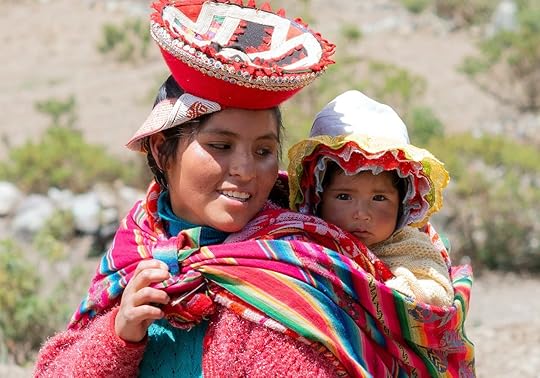
Photo: dani3315/Shutterstock
Andean mothers wear a manta. These thick, woolen, blanketlike fabrics are beautifully woven textiles. They can be made from sheep, alpaca, or llama wool and are tied around the neck and shoulders.
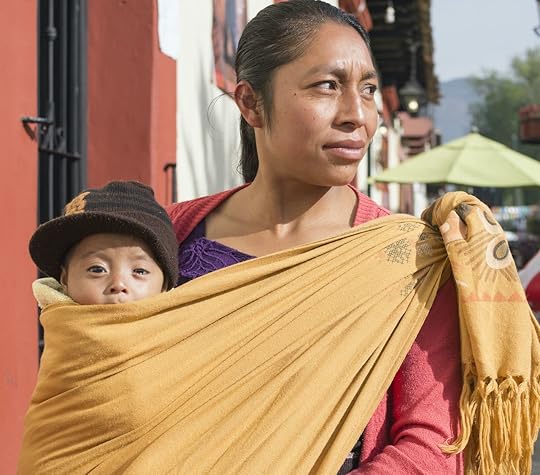
Photo: Chad Zuber/Shutterstock
Throughout Mexico, rural weavers and other craftswomen wear babies in a rebozo, a long, narrow rectangle of fabric that indigenous Mexican women use to attach their kids to their hips or front of the body. It’s usually woven from cotton on a backstrap loom.
Kogi women of Colombia strap their newborn to their backs in a large cloth similar to other slings around the world. However, their slings add an additional strap that goes around mom’s forehead.
In Asia
In Asia, colorful baby slings tend to involve more straps than those found in other parts of the world.
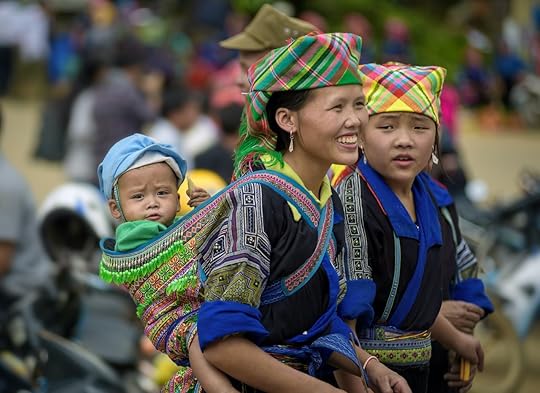
Photo: /Shutterstock
One of the most ornate examples of baby carriers found in Asia is the one crafted by the Hmong people, an ethnic group living in Laos, Thailand, Vietnam, Myanmar, and southwestern China. Made of material decorated by intricate embroidery, appliqué, and reverse appliqué, Hmong baby carriers consist of a large rectangle of vibrant fabric on which two straps are sewn at the top. Baby is wrapped by the cloth on the mom’s back and tightly secured by the straps that weave around the mom’s arms, below the baby’s behind, and around the mom’s waist.
In Japan mothers craft a carrying device called an onbuhimo to strap the child to their back. Likely developed by indigenous islanders, it looks like a typical daypack but with wider straps. It is strong enough to transport kids ranging from infant to toddler-size. Today, onbuhimos are also created both by hand and in factories for mothers all over the world. Instead of fabric, straps are now often made of webbing.
Cradleboards
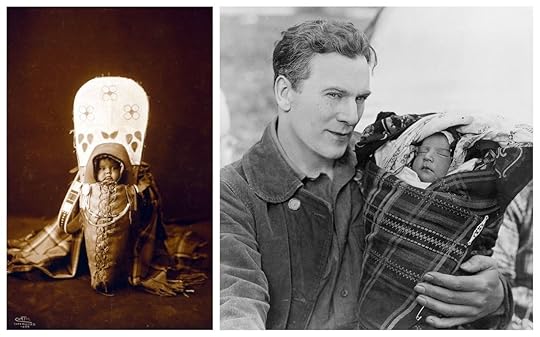
Photo: Everett Historical/Shutterstock + Everett Collection/Shutterstock
Cradleboards are traditional to cultures around the world, and while they might seem harsh or too firm, they were used for centuries to swaddle and safely transport Native infants. Cradleboards are sacred to the Ojibwe, Lakota, Hopi, Navajo, Kiowa, Comanche, and Iroquois peoples of North America. In North America cradleboards are often erroneously called papooses, which actually means “child” in the Algonquian language. Cradleboards were also used by cultural groups outside the continent, like the reindeer-herding Saami people of Norway, Sweden, Finland, and a small part of Russia.
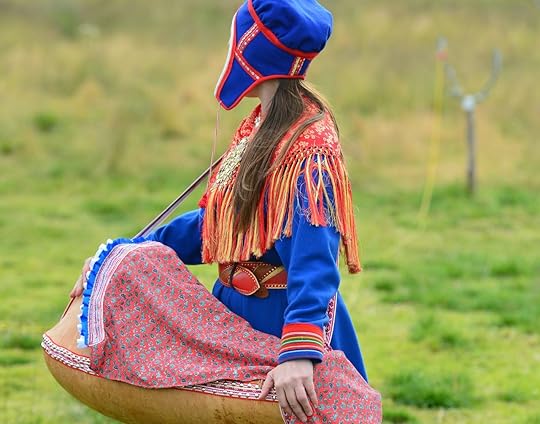
Photo: V. Belov/Shutterstock
According to Dawn Scher Tomae, Curator of Anthropology Collections at Milwaukee Public Museum, cradleboards are no longer used as baby transporters but rather as vehicles of cultural continuity. At least among Native American peoples, now cradleboards are ornately decorated and passed down through the generations as ways to connect with the ancestors.
“Cradleboards are not used as the typical way to carry babies today even by most indigenous peoples … nor were they used by all North American Indian tribes. With that said, there has been a resurgence in their creation to a limited extent … as a way to affirm a connection to the ancestors through cultural identity. Miniature cradleboards, too, were made for dolls for children and then later for tourists (especially the Apache ones are quite well known),” she said.
Amautis
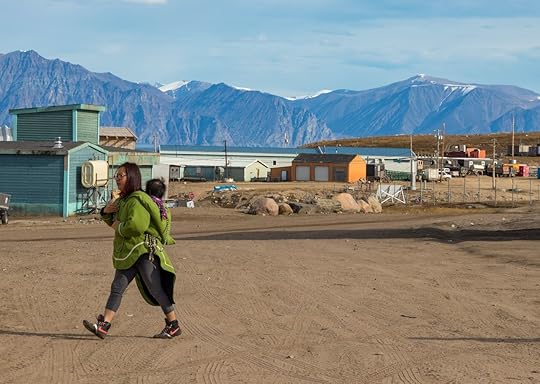
Photo: RUBEN M RAMOS/Shutterstock
Wrapping a baby in the mother’s own clothing is particularly beneficial in cold climates. The Inuit mothers of Northern Canada know all about harsh weather and below-zero temperature and traditionally carry their infants until two or three years of age in an amauti, a woman’s coat made of animal fur and sinew. Today, amautis can be made of other material, such as quilted cotton, but the design remains the same: an overhead parka with large shoulders, two flaps (one short one in the front and one long one in the back), a large hood, and a baby pouch.
The baby is carried in the pouch at the back of the parka, below the hood, and can either have their legs around the mother’s waist, be swaddled in cloth and “stand” in the pouch, or sit. In this pouch, the baby has constant contact with its mom, and the large shoulders of the garment allow for the child to be brought to the front for feeding when needed. The hood can be pulled up to protect both mother and child from the cold. Different regions have different styles: Some have wider shoulders; others are more or less decorated. Generally, they are colorfully beaded and trimmed with various furs.
Baskets
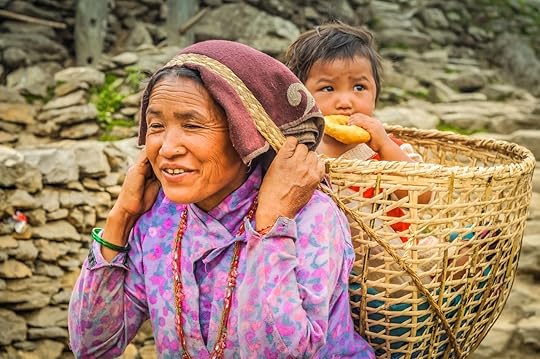
Photo: Michal Knitl/Shutterstock
While more cumbersome and heavier, baskets are one of the many ways mothers around the world carry their little ones. In Nepal, the practice of carrying infants in wicker baskets strapped to the mom’s head is very common. The shapes and sizes of baskets vary, from very common and traditional conical ones called doko to rectangular ones, but they all do the job and free up the hands of busy mothers. When not used for infants, the baskets can carry crops, wood, etc. 

More like this: 7 fascinating female-led societies around the world
The post The wonderful and varied ways mothers carry their babies around the world appeared first on Matador Network.
Irish help Native Americans
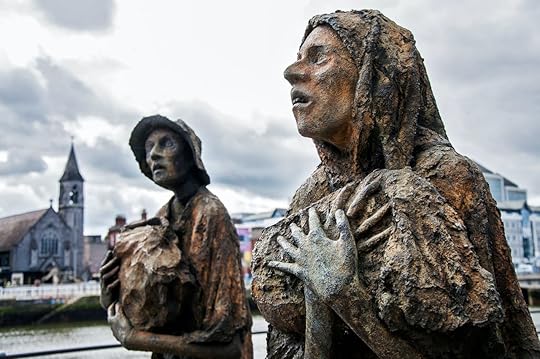
When providing help to those in need, you don’t expect anything in return, especially more than 170 years after the fact. But the Irish have never forgotten what the Choctaw Nation did for them so many years ago.
Back in 1847, the Choctaw Nation was in the process of establishing itself in Oklahoma, after being driven out of its ancestral lands in Mississippi in what is known as the Trail of Tears. Even considering their own loss and difficulties, when the Choctaw people heard about the Great Famine in Ireland, which killed one million people, they donated $170 to the struggling Irish people — which in today’s terms, equals about $5,000.
During the COVID-19 pandemic, the Navajo Nation and Hopi Reservation have found themselves at risk. They lack access to clean water and are located in extreme food deserts, making it extremely difficult for them to obtain essentials. The communities also include many elderly people, as well as people with conditions that make them vulnerable to the virus. During the intensifying stages of the pandemic, the Navajo and Hopi families set up a GoFundMe campaign to raise money for the communities and the money poured in from an unlikely place: Ireland.
Messages that accompany the donations convey the gratitude of the Irish toward the Native American communities. “What comes around goes around. With thanks from Ireland,” said one donor. “My ancestors may have starved without the help of the Choctaw people. Thank you,” said another one.
Over $1.8 million has already poured in, much of it from Irish donors. 

More like this: 11 important Native American heritage sites in the US that you need to visit
The post Thankful Irish give back to the Native American communities that helped during the famine appeared first on Matador Network.
Matador Network's Blog
- Matador Network's profile
- 6 followers



